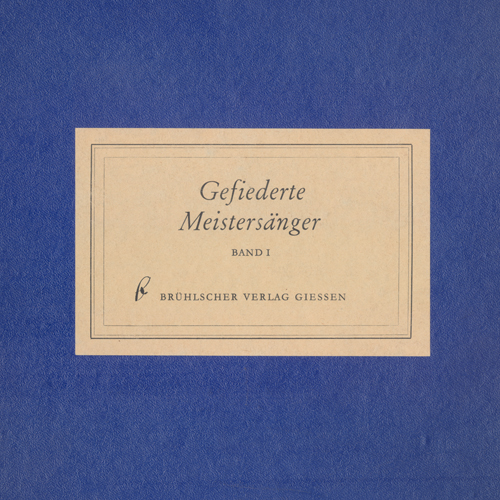Gefiederte Meistersänger (Feathered Mastersingers).
LUDWIG KOCH
(Brühlscher Verlag Giessen 1935)
Review by Cheryl Tipp
Ludwig Koch was almost certainly the first field recordist to make wildlife recordings using a microphone. Having begun his career in the days when acoustic recording was the only option available, Koch was thrilled to begin experimenting with electric recording in the field. Early efforts were greated with success and outputs included the 1934 sound book ‘Der Wald Erschallt’ (‘The Wood Resounds’). This double-sided disc dedicated one side to the extensive vocabulary of the Red Deer and the other to a montage or “sound-picture” of thirteen birds. One of the finest features of this montage is a recording of the song of the Golden Oriole. Koch’s delight at making this early electric recording is beautifully summarised in his autobiography ‘Memoirs of a Birdman’:
“The town (Spandau) was overshadowed by its prison and Prussian barracks, but there was freedom where I was watching and waiting, and when, above the music of all the other birds, there arose the song of the Golden Oriole, my heart overflowed with joy.”
Encouraged by the success of these initial experiments, Koch was eager to start building a comprehensive collection of wild bird recordings by electrical means. Together with the prominent ornithologist, Oskar Heinroth, Koch embarked on an ambitious project to record the songs & calls of twenty-five common German birds and release these in the form of a sound book. Despite weeks of extensive preparations, which seemed so achievable and efficient on paper, Koch and his small team of engineers from the Carl Lindström Company faced many obstacles.
“It took us weeks to get the sound to come through the microphone and the cables, and any humidity caused a short circuit.”
Even the logistics of transporting the recording equipment to the desired location was a challenge; difficult terrain sometimes meant that a mile of cable was required to link the microphone with the recorder, a method which exacerbated problems such as short circuits. Never one to throw in the towel, Koch and his team persevered and overcame each hurdle that nature put in front of them. His first success came in the form of the song and calls of the Siskin, but this small triumph was tempered by another short circuit which rendered the machinery unusable for the next few days. Despite this series of setbacks, Koch eventually reached his target of twenty-five species. A total of three hundred and eighty wax discs had been used to achieve this.
In the autumn of 1935, Koch and Heinroth saw their project realised when ‘Gefiederte Meistersänger’ was published. This attractive sound book comprised three double-sided 78rpm discs and an accompanying book which devoted a chapter to each of the twenty-five species whose voices could be heard on the records. From the comfort of their homes, people could listen to and learn how to identify the sounds of some of Germany’s most celebrated songsters. The fluting song of the Blackbird sat alongside the Skylark’s unbroken stream of melodious notes and the Nightingale’s strident advertisement of his vocal talents. The popularity of ‘Gefiederte Meistersänger’ was such that a second volume was published two years later, at which point Koch had fled his native Germany and embarked on new recording adventures in Britain. This publication has a firm place in the history of commercial wildlife sound recording however, being the first comprehensive audio identification guide to bring together both audio and written resources for the general public to use and enjoy.



